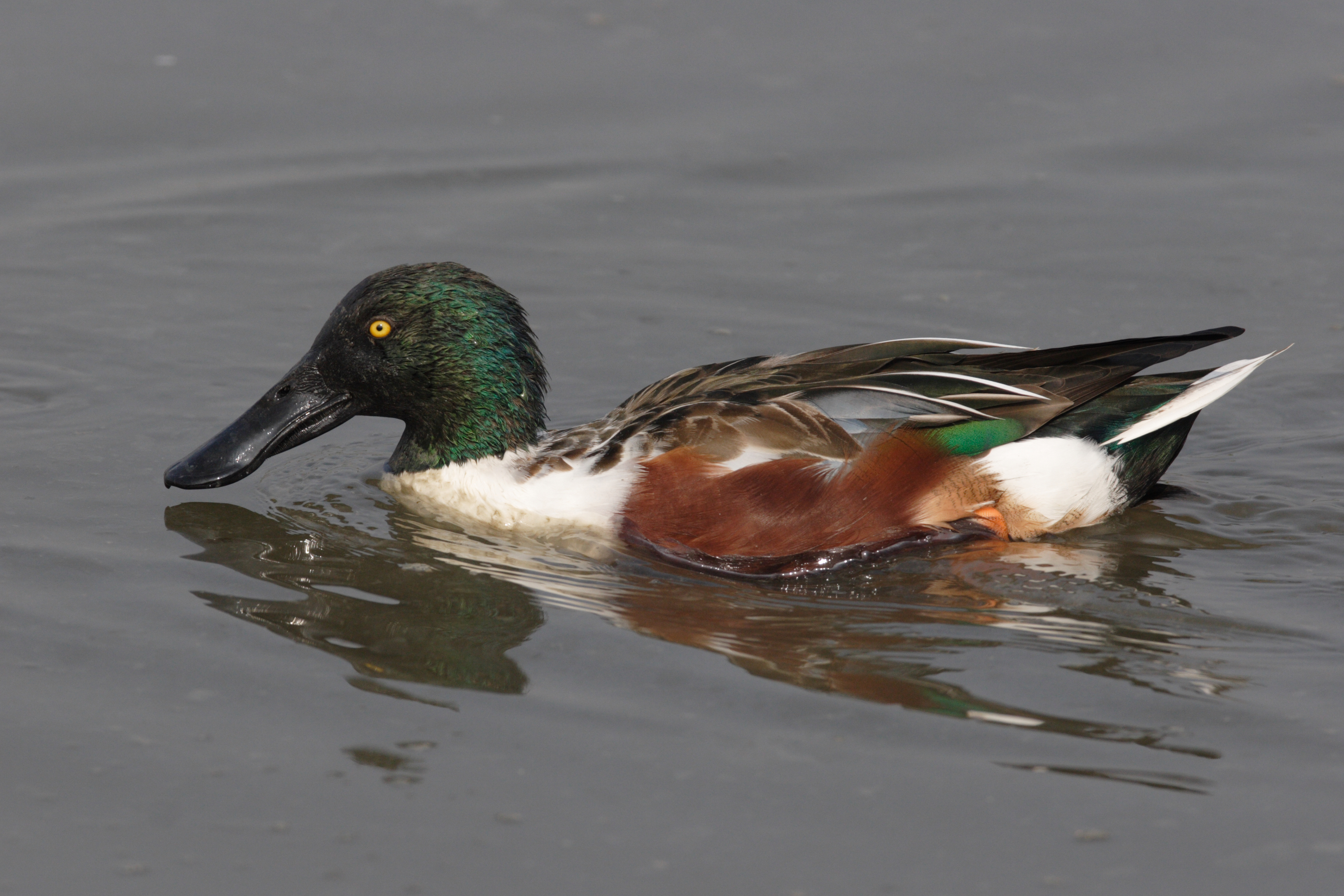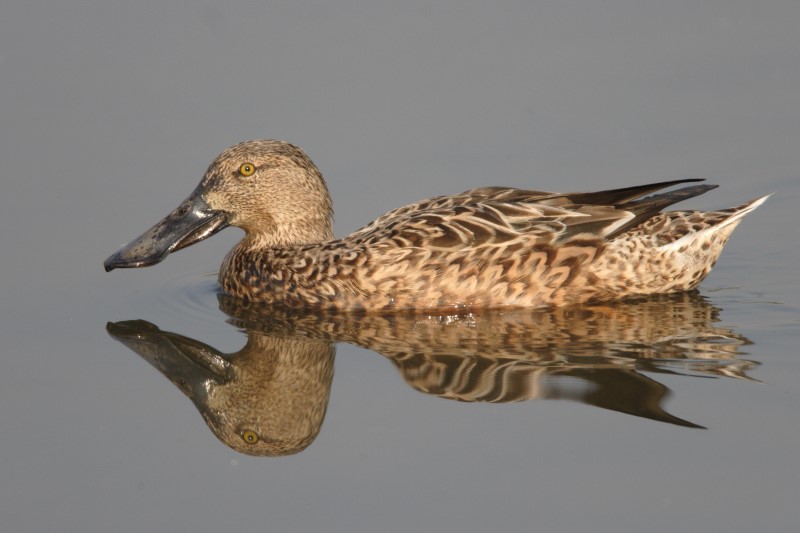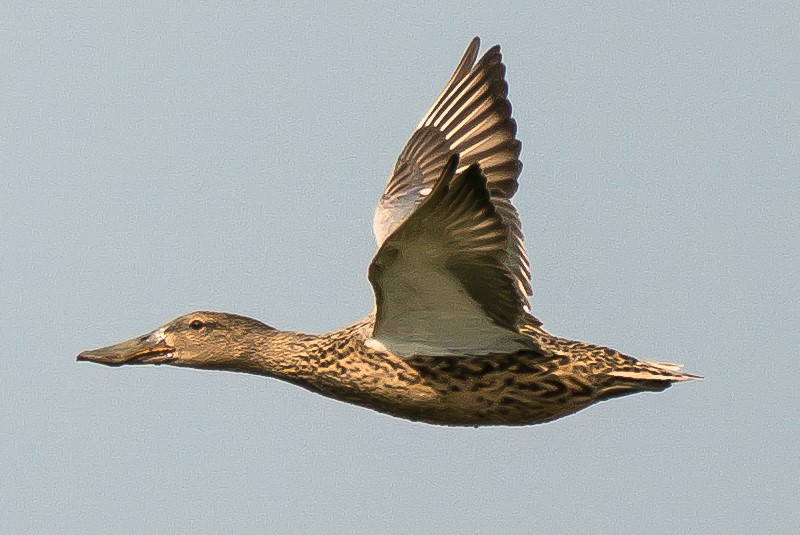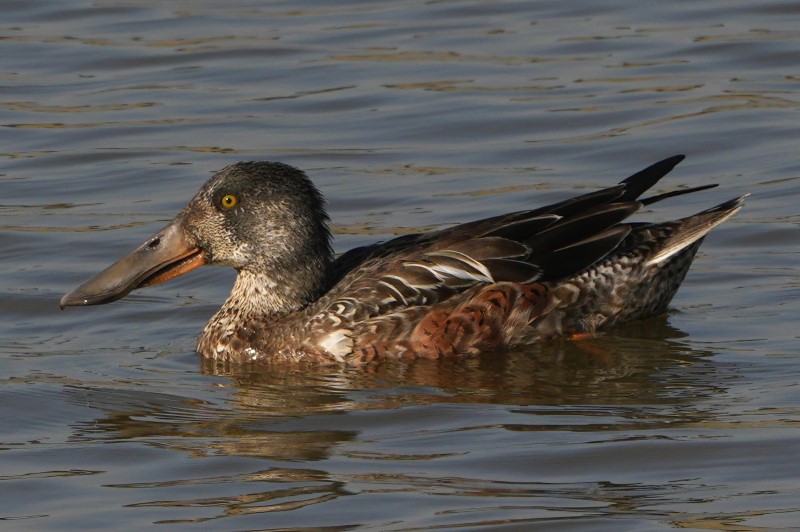Northern Shoveler Spatula clypeata 琵嘴鴨
Category I. Abundant winter visitor to the intertidal areas of Deep Bay typically present October to April.
IDENTIFICATION

Jan. 2005, John and Jemi Holmes. Male.
Fairly large and bulky duck with distinctive long spatulate bill. Adult male in breeding plumage has dark green head and contrasting yellow eye, white chest and mantle, warm brown flanks and belly, blue inner wing coverts showing as an obvious wing panel in flight and black upper and undertail coverts.

Jan. 2005, John and Jemi Holmes.
Adult female has pale orange sides to the bill and orange legs, pale brownish body with clear dark centres to the feathers, pale sides to the tail and a relatively plain face.

Dec. 2020 Kenneth Lam.
In flight has relatively short tail, white underwing coverts, grey wing panel and greenish speculum with no obvious white trailing edge.

Dec. 2024 Paul Leader.
Adult male eclipse similar to female but has more rufous body, darker head, brighter forewing panel and darker bill. There is a plumage intermediate between this and breeding plumage that produces a whitish crescent around the front of the face and pale sides to the head.
VOCALISATIONS
A decrescendo quacking is uttered by the male.
When alarmed, the male can give an unusual nasal call that comprises one or both of a clucking and wheezing call.
The female when flushed gives a series of single and often double-note quacks
DISTRIBUTION & HABITAT PREFERENCE
The great majority of the winter flock remains in the intertidal areas of Inner Deep Bay, while small numbers are also recorded in the shallower parts of the brackish gei wai and freshwater ponds of Mai Po Nature Reserve and commercial fish ponds. It also forages along tidal waterways draining into Deep Bay such as Shan Pui River and Kam Tin Main Drainage Channel, Ngau Tam Mei Drainage Channel and San Tin East Main Drainage Channel, usually from late October to the end of March.
The regular surveys carried out by HKBWS at Long Valley have recorded Northern Shoveler regularly in freshwater marsh in small numbers from late October to mid-March, with the peak count being 35.
There are rather few records away from the northwest New Territories: up to two at Shuen Wan, up to three at Nam Chung, and on Lantau at Pui O, all between 4 November and 15 March.
OCCURRENCE
Northern Shoveler is an abundant winter visitor to Deep Bay primarily from the first week of October to the third week of April; numbers recorded from mid-May to the first week of September rarely exceed three birds. Records of over-summering birds have occurred in 1989, 2007 and 2008.
Figure 1 illustrates the pattern of Deep Bay counts each winter period since waterbird counts commenced. While it seems there was an increase in the initial years, it is possible this was an artefact due to better access to the Deep Bay mudflats. The highest count on the HK side of the bay is 7,567 on 16 January 2011, while the highest count for Deep Bay as a whole is 20,008 on 24 January 2010, when the majority of birds were present at Futian National Nature Reserve (NNR), Shenzhen. This is almost 6,000 more than the next highest count, which was 14,253 in January 2008, which also largely comprised birds recorded at Futian NNR and was at least double all other counts.
As Figure 1 also indicates, the winter periods 1992/93 to 1998/99 and 2004-05 to 2011-12 generally saw high numbers present in Deep Bay as a whole, though in the latter period numbers on the HK side of the bay were somewhat lower. It is possible that these very high numbers in the latter period occurred as a result of the displacement of birds wintering elsewhere, and that their arrival resulted in large numbers using the Fu Tian side of the bay, as the carrying capacity of the Hong Kong side was exceeded.
Both Swinhoe (1861) and Kershaw (1904) referred to Northern Shoveler as being common in HK and Guangdong respectively, while Vaughan and Jones (1913) referred to it as occurring ‘not infrequently’ in the Pearl River Delta.
BEHAVIOUR, FORAGING & DIET
The majority of time is spent foraging in or roosting on the water, and most birds remain in intertidal areas of Deep Bay. It generally occurs in loose flocks, though these can be large and to a substantial extent separate from other ducks, including Northern Pintail, which is the second species that occurs commonly in intertidal areas.
There are no records of prey items consumed in HK. The bill is used to strain food items from the water and birds are often seen filtering water from the surface via dabbling or the use of a side-to-side head motion with the head and neck submerged, occasionally upending. Often forages in small groups of birds that appear to be agitating the water. Also forages while wading or walking on wet mudflat.
RANGE & SYSTEMATICS
Monotypic. Holarctic breeding distribution, though absent from eastern half of north America and western Europe, and patchily distributed in eastern and northern Europe. Winters in areas to south as far as northern South America and central parts of west and east Africa, as well as western Europe. In China breeds in northwest and northeast, and winters along the east coast and areas from the Yangtze floodplain south to the coast, reaching both Taiwan and Hainan (Liu and Chen 2020).
CONSERVATION STATUS
IUCN: Least Concern. Population trend decreasing.
Figure 1.

Dubowy, P. J., C. Carboneras, and G. M. Kirwan (2020). Northern Shoveler (Spatula clypeata), version 1.0. In Birds of the World (S. M. Billerman, Editor). Cornell Lab of Ornithology, Ithaca, NY, USA. https://doi.org/10.2173/bow.norsho.01
Kershaw. J. C. (1904). List of birds of the Quangtung Coast, China. Ibis 1904: 235-248.
Swinhoe, R. (1861). Notes on the ornithology of Hong Kong, Macao and Canton, made during the latter end of February, March, April and the beginning of May 1860. Ibis 1861: 23-57.
Vaughan, R. E. and Jones, K. H. (1913). The birds of Hong Kong, Macao and the West River or Si Kiang in South-East China, with special reference to their nidification and seasonal movements. Ibis 1913: 17-76, 163-201, 351-384.
Liu, Y. and Y. H. Chen (eds) (2020). The CNG Field Guide to the Birds of China (in Chinese). Hunan Science and Technology Publication House, Changsha.

